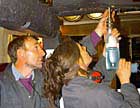

Ye Olde Trip to Jerusalem team
- [dendrochronology]
![]()
dendrochronology
 |
Robert Howard and Alison Arnold drill out a sample from a beam at the Trip |
The origins of the down-to-earth science of dendrochronology -- the study of the chronological and environmental information contained in the annual growth layers of trees (tree rings) -- lie in sunspots!

Early this century, as astronomer Andrew Douglass was in Flagstaff, Arizona studying the effects of sunspots on climate, he found that he had no weather records that corresponded with the 22-year sunspot cycle. Deciding to use tree rings, he eventually compiled a continuous 450-year record of rings that showed that the variability in their widths was highly correlated with the level of rainfall during the winter preceding the growth year. Wide rings roughly indicate good rainfall and narrow ones show that the tree was under stress of some kind, usually from drought.
Archaeologists were quick to realise the potential of Douglass's method for dating pieces of ancient wood. In 1929, the discovery of a charred log from a site near Show Low, Arizona allowed the linking of two dating sequences to make a total of over 1,000 years of tree rings in the American South-west. For the first time, precise calendar dates could be assigned to prehistoric sites. Such a date is arrived at by drilling a core of wood and finding the unique point at which the sample's ring-width sequence -- which resembles a bar code -- matches the pattern of a dated chronology.
Since then, tree-ring sequences have been developed in many parts of the world -- as they have to be, since climate varies from place to place. The longest are an 8,700-year sequence taken from bristle-cone pines in California and a 10,000-year sequence from central Europe.
 |
the dendro sample from the Trip |